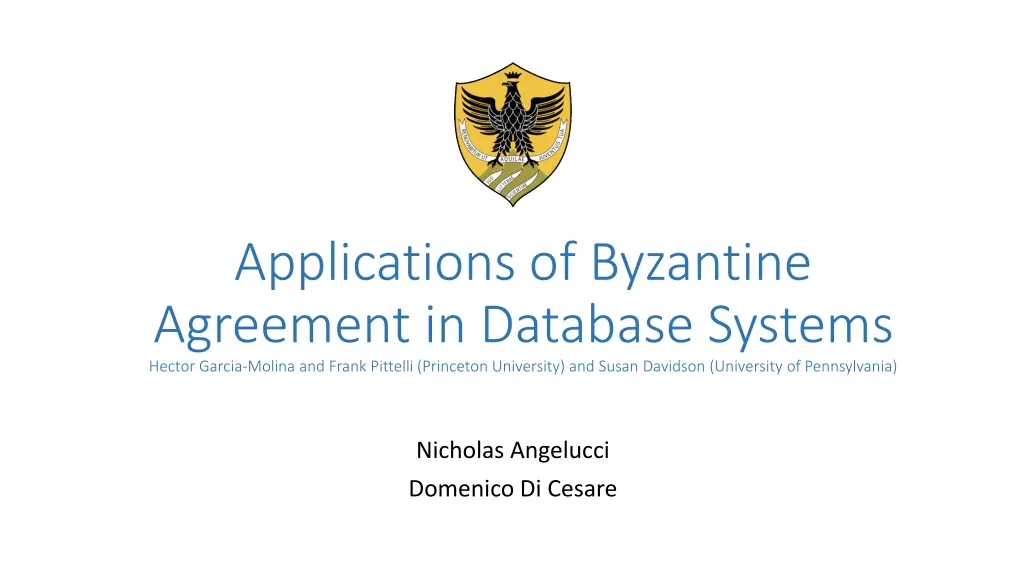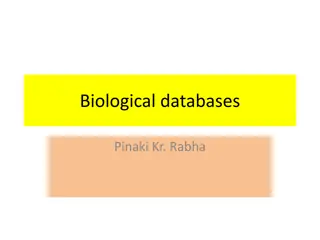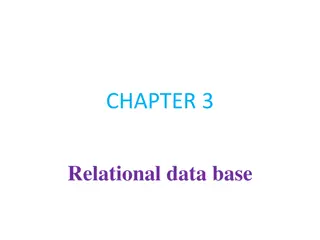
Applications of Byzantine Agreement in Database Systems
Exploring the utility of Byzantine agreement protocols in database systems, this paper discusses the challenges of achieving consensus in the face of failures, models for input/output nodes, and the distribution of input transactions. It delves into different failure environments and strategies for resilience in distributed processing.
Download Presentation

Please find below an Image/Link to download the presentation.
The content on the website is provided AS IS for your information and personal use only. It may not be sold, licensed, or shared on other websites without obtaining consent from the author. If you encounter any issues during the download, it is possible that the publisher has removed the file from their server.
You are allowed to download the files provided on this website for personal or commercial use, subject to the condition that they are used lawfully. All files are the property of their respective owners.
The content on the website is provided AS IS for your information and personal use only. It may not be sold, licensed, or shared on other websites without obtaining consent from the author.
E N D
Presentation Transcript
Applications of Byzantine Agreement in Database Systems Hector Garcia-Molina and Frank Pittelli (Princeton University) and Susan Davidson (University of Pennsylvania) Nicholas Angelucci Domenico Di Cesare
Index 1. INTRODUCTION 2. MODELING FAILURES 2.1 Node Models 2.2 Network Model 3. BYZANTINE AGREEMENT PROBLEM 4. APPLICATIONS OF BA IN DATA PROCESSING 4.1 Outputs 4.2 Inputs 4.3 Lazy Input Nodes 4.4 Erratic input Nodes 4.5 Recovery From Insanity 4.6 Cost of Full Replication 5. ANY OTHER USES OF BA? 5.1 BA with Sane Nodes 6. CONCLUSIONS
1 Introduction This paper analyze like a Byzantine agreement protocol can be used in general-purpose database management systems. We show a overview: of correctness criteria for database processing in this failure environment and discuss strategies for satisfying them. failure models for input/output nodes and study ways to distribute input transactions to processing nodes under these models. applications of Byzantine agreement protocols in the more common failure environment where processors are assumed to halt after a failure.
1 Introduction Byzantine agreement (BA) is the problem of making a set of processors, some of which may fail in arbitrary ways, agree on a common value . Consensus Consensus with Crash Failures All the processors decide the minimum exactly over the same set of values The simple algorithm doesn't work
sane insane 1 Introduction 101000101 101100101 A reliable system must be able to perform useful and correct computations in the face of failing components. The agreement problem turns out to be fundamental in reliable computing, and illustrates the subtleties (sottigliezze) that appear in coping with faulty processors. The goal of the paper, that we analyze, is to study when and how Byzantine agreement protocols can be of use in general-purpose database processing. 101000101 101100101
1 Introduction There has been considerable controversy in the database community with regards to the applicability of Byzantine agreement, mainly because of the high message overhead of its solutions. 1. The first step in any reliable system design is to define the expected operation of each component during both normal and failure periods. 2. We present the operation models of our distributed system 3. Based on these models, we present one version of the BA problem and outline its solution. 4. The application of BA is in the distribution of input transactions to a set of processors with a replicated database. 5. We look at a failure environment different from that typically used in BA and discuss the uses of BA protocols in such an environment.
2 Modeling Failures Multiple processors are necessary for reliable computing. In this model, all processing needed by the distributed application is performed at the nodes, while any processing needed for communication (e.g., routing) is performed by the network.
2.1 Node Models Insane node. A failed node can send any message and it can refuse to send messages. It can even collaborate with other failed nodes in an attempt to subvert the entire system. (For the time being we assume that insanity is a permanent property. Later on we consider the case where a node can be repaired and stop to be insane.) Perfect node. A perfect node is one that never fails and responds promptly to messages from other nodes. If a node is perfect, it is perfect for all time. It respects the algorithm's steps. Crash node. It is a node failure model that lies between perfection and insanity (usually not employed in BA problems). When a sane node fails, it simply halts, without ever deviating from its algorithms. It may lose the data contained in memory, but the data contained in stable storage are protect by the failure.
2.2 Network Model Additional assumptions about the network (N) and timing (T) Assumption T1 Perfect nodes have accurate and synchronized clocks. Specifically, at any instant the clocks differ by at most time units. Assumption N1 The network delivers all messages correctly. Any message sent from node x to y is eventually delivered. Messages are not altered in any way, and the network never generates spontaneous messages. Assumption T2 The network has a guaranteed delivery time. The network delivers all messages (between perfect nodes) within Td time units. Assumption N2 Messages are authenticated. All messages are signed and encoded by senders in such a way that the receiver can determine unequivocally who sent the message and what it contained. A third node that simply forwards the message cannot alter it in any way. Assumption T3 The processing time of perfect nodes can be bounded.
3 Byzantine agreement problem The problem is that at time 0 a general node wants to broadcast, in a bounded time, a value v to a set of n lieutenant (lungotenenti) nodes. Some of the nodes, including the general node, may be insane. Let m be the maximum number of nodes that are insane. Nodes that are not insane are perfect. Condition 1. When the algorithm stop, all perfect lieutenants agree on the same value. Condition 2. If the general is perfect, then all perfect lieutenants agree on the value sent by the general. Three step a. Lieutenant Lj receives a value from the general. b. Lieutenants exchange the values they received so that they all know the different values v1, v2,...,vq that were broadcast by the general (tricky step). c. Once Lj knows the list v1, v2,...,vq it applies a fixed rule to obtain the single value it will agree on. For instance, they may choose a standard null value, or the average of v1, v2,...,vq. G G V v1, v2,...,vq v v ? v ? ? Li Lj Lk Li Lj Lk
3 Byzantine agreement problem Ex2 G Ex1 Solution 1. The first safeguards is to have lieutenants broadcast, not just the value they receive from the general, but also additional values they receive from other lieutenants. The second safeguard is to put a limit on the time that lieutenants will wait for new values. Li V1 V2 v1, v2,...,vq Lj Lk Solution 2. Assumption N2 Messages are authenticated Li Lj/LK V1:G:Li
3 Byzantine agreement problem 0is the start time is the maximum clock drift (assumption T1) Td is the guaranteed delivery time (assumption T2) Ts is the maximum time it takes a perfect node to process and forward a value (assumption T3) If a lieutenant Li has not received a value from the general by time 0 + Td + + Ts (on its clock), then Li knows that the general is insane and can safely ignore any future messages from the general. Similarly, Li can ignore messages of the form Vk:G:Lj received after time 0 + + 2(Td + Ts). In general Li, can ignore any message of the form Vk:G:L1:L2:...:Lp, if it arrives after time 0 + + (p +1)(Td + Ts). At time 0 + + (m +1)(Td + Ts), Li can ignore all messages of the form Vk:G:L1:L2:...:Lp, where p m is the maximum number of insane nodes. However, Li can also ignore messages where p>m, for the following reason. If the general is perfect, then Li would have received the value Vk by time 0 + + (Td + Ts). If the general is not perfect, then the first of the two perfect lieutenants in L1,...,Lp, would have sent Vk to Li before 0 + + (m +1)(Td + Ts). (In the worst case, Lm, is the first perfect lieutenant. It must have received Vk:G:L1:...:Lm-1 by 0 + + m(Td + Ts) and then sent Vk:G:L1:...:Lm to Li. In either case, Li receives Vk before 0 + + m(Td + Ts).
3 Byzantine agreement problem In summary, in step (b) lieutenants proceed as follows. Any message Vk:G:L1:...:Lp(p 0) that arrives is checked for correctness and timeliness. If the message has the correct format and signatures and if it arrives on time (before 0 + + (p +1)(Td + Ts)), then the value in the message is added to the list of values and is broadcast to other lieutenants. Similarly, if p m, the value does not have to be broadcast at all because one of G, L1,...,Lp is perfect and has already broadcast the value. Finally, at time 0 + + (m +1)(Td + Ts) step (b) completes, and the resulting list of values is passed to step (c) for the final decision. Conclusion The algorithm we have outlined guarantees agreement as defined by conditions 1 and 2, even if there are very few perfect nodes. If there is one or no perfect node(s), then conditions 1 and 2 are satisfied trivially. If there are just two perfect nodes, they will reach agreement no matter how many insane nodes there are.
4 Applications of BA in data processing We show as to do reliable data processing. So, we investigate the applications of BA in this environment. Users submit transaction (ex. withdraw ten million dollars from account 150). Each transaction is run as an atomic unit against the database, and the results are given to the users. Three simplifying assumptions about transactions 1. Transaction contain user authentication information. Transactions from unauthorized users are discarded by the database system. 2. Each transaction originates from a single user. The user can be a military commander, a customer at an automatic teller machine, or a company manager. 3. The input/output functions are performed by input/output nodes that are different from the processing nodes. BA condition: the n data processing nodes are either perfect or insane, and there are at most m insane nodes. We continue to make assumptions N1, N2, T1, T2, and T3.
4 Applications of BA in data processing We want the system to satisfy the following conditions. Condition C1: Users should obtain the sane results from the system that they would obtain from on ideal system where no failures occur. Condition C2: If a transaction Ti is submitted at a perfect input node, then Ti will be in the resulting schedule S. (If a user submits a transaction to withdraw 10 million dollars, either that exact operation is performed, or nothing is done. Withdrawing 9.9 million is not considered correct). Condition C3: The time to commit a transaction is bounded. The commit decision is irreversible. Having defined our correctness criteria, now discuss how such a system could be constructed, and what additional assumptions have to be made. Suppose we have a single copy located at node Ni. If Ni were insane, it could do whatever it wished with the database. The database could easily be ruined, and this would violate condition C1. The solution is to replicate the database at several nodes. Can be up to m insane nodes, we need at least m+1 copies to ensure that at least one perfect node manages the data correctly. Unfortunately, we cannot tell which is the perfect node, so m+1 copies are not enough. We actually need 2m+1 copies. In addition to having 2m+1 copies, it is also necessary that all perfect nodes execute exactly the same transactions, in the same order (Not respect order, need equivalent result).
4 Applications of BA in data processing The strategy of replicating processing and voting on outputs has been called the state-machine approach. The authors of the paper also decided to do the database computations for a transaction at the same node where the data is located. (Notice that this full replication environment is very different from conventional distributed database processing, because there is little communication between the nodes). The nodes must agree among themselves as to what the input transactions will be (discussed in subsection 4.2). The outputs of each transaction must also be compared in order to select the majority, correct one (discussed in subsection 4.1). Unlike conventional processing, here nodes do not have to communicate to execute the transactions. A node does not have to request locks from the other nodes, and there can be no global deadlocks. There is no need to decide what node will execute a transaction, they all do. The updates made by a transaction do not have to be broadcast to other nodes: all (perfect) nodes will make the same updates automatically.
4.1 Outputs Consider a transaction T, submitted to the system by a user Now, after T is executed at 2m+1 nodes, at least m+1 nodes have the correct result For the R3 assumption the output node obtains 2m+1 results for T, from this results, it selects the majority value and transmit it to the user But the output node is a critical component and it cannot be insane Because if an output node is insane, it could invalidate the results of the processing nodes by conveying garbage to the users This is a contraddiction!
4.1 Outputs To solve this problem there are 2 alternatives: 1) to move the output node to the user s head In this way the user examine a 2m+1 result of his transactions and make the majority operation That s not good for two motivations: The system must provide the burden failure, not the user The users aren t always perfect 2) to relax the failure model for output nodes When a user submits a transaction and it fails to get the output, the user can submit a query (directing the output to a different device) and see if his transaction committed, and, if so, what the results were
4.2 Inputs An input node is a critical component, its goal is to take a single transaction or command and distribute it to the processing nodes Let s temporarily assume that all input nodes are perfect, so, they can satisfy C1 condition This means that the processing nodes must execute the same sequence of transactions So, in this way, all perfect processing nodes will not have to compare their inputs with each other
4.2 Inputs A few observation about this solution: 1) If two conventional database systems are given identical sequence of transaction, they may process them in different orders (thats because of the randomness of internal states) But in our environment this is not possible, and there are a several number of linear tecniques for doing this 2) C2 conditions and C3 conditions are trivially satisfied; actually, the bound of C3 is 0 3) For the two observations above, the transactions will be processed at the speed of the slowest input node To avoid this problem, we can set up the following convention: Input nodes transmit one transaction every time units If a processing node does not receive a transaction from the input node in units, then the transaction is considered null If the input node needs to transmit more than one transaction in units, it numbers them and process them as a single transaction This solution relies on the synchronized clocks that perfect input nodes have
4.3 Lazy Input Nodes In the previous model we have assumed that if a processing node receives a transaction from an input node, then it is correct because it was submitted by a user However an input node may: - Fail to send the transaction to some or all the processing nodes - Send messages at any time - Send the transaction in any order This type of input node is called lazy node Problem: an input node could hold a transaction arbitrarily long to broadcast, violating condition C3 and, also, it could broadcast it promptly to an insane processing node but then die Assumption: the input nodes must attach a timestamp to each transaction, giving its arrival time Now it only remains to make sure that perfect nodes execute identical sequences of transactions
4.3 Lazy Input Nodes Solution: Let us say that the processing nodes agree to perform BA every time units can have a value greater or smaller than is the maximum clock drift tD is the guaranteed network delivery time tr is an estimate of the time an imput node takes to process an incoming transaction 1) Each processing node collects transactions received from the input nodes 3) At time i the messages, have to deal with transactions with timestamps between: and the BA is complete and each perfect processing node has the same set of transactions. These are ordered (lexicographically or by timestamp) and executed after the transactions of the previous complete cycle that is the duration of each BA 2) At time i each node selects the transactions with timestamps between: i -( +tD+tr). After time i , transactions arriving with a timestamp less than i -( +tD+tr) (i-1) -( +tD+tr) and are discarded (i-1) -( +tD+tr) i -( +tD+tr) 4) At time i + +(m+1)(tD+tS)
4.4 Erratic Input Nodes An erratic input node transmit an erroneus transaction TI to some processing nodes, while the transaction submitted by the user is T Let s assume that the erratic input nodes will transmit a given erroneus transaction TI to at most q processing nodes To satisfy condition C1, the processing nodes cannot execute TI instead or in addition to T, so the processing nodes are forced to use vote to identify a correct transaction To guarantee an erroneus transaction doesen t get the majority of votes, we need increase the number of processing nodes In general, if TI can be received from q nodes, we need to have at least 2(q+m) processing nodes to prevent an erroneus transaction from being processed So, the new algorithm will be very similar to the algorithm for lazy nodes, the difference is in step 4, where only transactions received at a majority of nodes are executed
4.5 Recovery From Insanity It is possible to repair insane nodes so that the system can tolerate additional failures
4.6 Cost of Full Replication The cost of full replication, that is of data and processing, is high, so it must be considered when the system is designed Specifically, for each insane failure we wish to tolerate we must add to the system 2 processing nodes, each with a copy of the database In general a system with: n processing nodes can tolerate x sane failures and y insane failures it provides correct data available, as long as n-x 2y+1 Full replication is expensive, there are a lot of ways to control its cost: 1) Using a fast local area network to interconnect the nodes 2) To replicate only the critical parts of the database and the other data could be handled with a single copy, this reducing considerably the storage requirements
4.6 Cost of Full Replication 3) If the replicated database is relatively small or if the network has a large bandwidth, the crash recovery mechanism for each copy can be eliminated, so that this makes each processing node more efficient for processing transactions during normal operations 4) Read-only transactions that are non critical can be processed as a single node. This reduces the amount of work that has to be performed by the nodes 5) If these ideas are combined, we can arrive at an intelligent backup storage device model: a large computer that has a copy of the entire database, and handles all transactions A critical part of the database is fully replicated at a number of smaller processors. These must execute the update transactions and the critical read operations Under the right circumstances the processing load will be relatively small, making it feasible to use inexpensive microprocessors Thus the devices are similar to backup disks, except that instead of receiving commands to write data and blocks of data, they receive transactions Given the cost of microprocessors, this approach is an alternative to backup copies
5 ANY OTHER USES OF BA? In this environment all data and processing are fully replicated, and there s a little interactions between the nodes. Once the nodes agree on the sequence of input transactions, they must not do anything else Nodes can process transactions in any order, and constantly vote on which is the next transaction to complete. This way the transactions are committed in the same order, and the resulting schedules at all nodes would be equivalent Serious flaw of this strategy: suppose that: m perfect nodes vote to commit a transaction T, and the last perfect node, Ni, vote to abort Without Ni we can t commit T: because we wouldn t the m+1 required correct results So the processing nodes must abort a transaction each time one or more nodes vote to abort But if we do this, the insane nodes will be able to paralyze the system by voting abort on all transactions! So the processing nodes should not wait until the end of the transaction to decide if it can be committed
5.1 BA with Sane Nodes If the processing nodes are sane, than we have the conventional distributed data processing; that is the database and transaction processing no longer needs to be full replicated. It is necessary an internode curcurrency control, and a two-phase commit protocol must be used to define transactions There are two ways BA protocols could be used in this environment: 1) to assume that: there are certain critical system operations that require the higher reliability provided by BA protocols. In this case, the system component that handles the operations, is designed so that it can withstand insane node failures The data used by the critical component are replicated to all nodes, and the update transactions are handled by a BA protocol There are a few potential problems with this approach. One is that the BA algorithms make no guarantee about the behavior of the failed nodes. A second problem with this approach is that it may be an overkill In this case: the BA protocols must be used with caution, identifying the users that require reliably data and protecting the data this users need. 2) to modify the BA protocols so that they use the sanity of the nodes That is, if the nodes are sane, then the BA algorithms can be semplified and the numbers of messages that must be sent can be reduced The algorithms that are obtained this way are very similar to conventional algorithms
6 CONCLUSIONS In this paper we have studied a BA algorithms and their application to distributed database processing We presented a distributed processing system and we have discussed the assumptions and conditions that specified the correctness of the system BA has other applications outside data processing, for example, may be useful in a clock synchronization algorithms In the section 4 we can discussed as BA can also be used to process inputs from sensors or other unreliable sources Finally, Domenico did a several assumption but we do not have formal ways; even so these are only simplifying assumptions and do not change the substance of our conclusions
References http://www.ece.uprm.edu/~bvelez/projects/WSSRL/p27-molina2.pdf






















